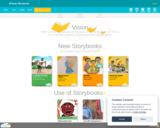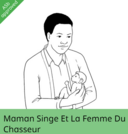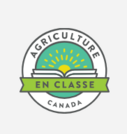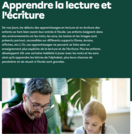
Ce journal vous offre les actualités de la France et autour du monde. Provenant de Paris.
- Subject:
- French
- Language Education
- Material Type:
- Primary Source
- Reading
- Author:
- LeFigaro
- Date Added:
- 05/01/2024

Ce journal vous offre les actualités de la France et autour du monde. Provenant de Paris.

Un journal d'actualités provenant de la France.

Le journal "Le Monde" de la France qui discute des actualités.

An interactive applet and associated web page that demonstrate acute angles (those less than 90 deg). The applet presents an angle (initially acute) that the user can adjust by dragging the end points of the line segments forming the angle. As it changes it shows the angle measure and a message that indicate which type of angle it is. There a software 'detents' that make it easy capture exact angles such as 90 degrees and 180 degrees The message and angle measures can be turned off to facilitate classroom discussion. The text on the page has links to other pages defining each angle type in depth. Applet can be enlarged to full screen size for use with a classroom projector. This resource is a component of the Math Open Reference Interactive Geometry textbook project at http://www.mathopenref.com.

An interactive applet and associated web page that demonstrate the three types of triangle: acute, obtuse and right. The applet shows a triangle that is initially acute (all angles less then 90 degrees) which the user can reshape by dragging any vertex. There is a message changes in real time while the triangle is being dragged that tells if the triangle is an acute, right or obtuse triangle and gives the reason why. By experimenting with the triangle student can develop an intuitive sense of the difference between these three classes of triangle. Applet can be enlarged to full screen size for use with a classroom projector. This resource is a component of the Math Open Reference Interactive Geometry textbook project at http://www.mathopenref.com.

An interactive applet and associated web page that show the concept of adjacent angles (two angles that share a common leg). The applet shows three line segments with a common endpoint. The user can move the center one and see that the angles on both sides (the adjacent angles) of it are affected. Applet can be enlarged to full screen size for use with a classroom projector. After use in the classroom, students can access it again from any web browser at home or in the library with no login required. This resource is a component of the Math Open Reference Interactive Geometry textbook project at http://www.mathopenref.com.

An interactive applet and associated web page that demonstrate the the concept of adjacent arcs. The user can 3 drag points around a circle that define the endpoints of two adjacent arcs. Web page has the properties of adjacent arcs. Applet can be enlarged to full screen size for use with a classroom projector. This resource is a component of the Math Open Reference Interactive Geometry textbook project at http://www.mathopenref.com.

This article has a ton of information on adolescent development such as physical development and their behavior. It gives statistics and shows the differences between boys and girls adolescent development. It also gives parenting advice about their kids sexuality and safety tips.

Voici une affiche pratique à mettre dans votre classe de français au secondaire afin d’illustrer aux élèves les principaux emplois de la virgule à maitriser pour chacun des niveaux du secondaire.

The African Storybook (ASb) is a literacy initiative that provides openly licensed picture storybooks for early reading in the languages of Africa. Developed and hosted by Saide, the ASb has an interactive website that enables users to read, create, download, translate, and adapt stories. The initiative addresses the dire shortage of children’s storybooks in African languages, crucial for children’s literacy development.

Le projet African Storybook est l'un des sites web les plus incroyables dédiés à l'alphabétisation, avec sa vaste gamme d'histoires destinées aux apprenants des classes de 1 à 3, écrites dans de nombreuses langues africaines. Ces histoires, disponibles sur www.africanstorybook.org et agrémentées de magnifiques illustrations, peuvent être lues en ligne ou téléchargées au format PDF pour être transformées en livres. Ils utilisent la licence Creative Commons, ce qui permet d'utiliser et d'adapter les livres librement, si tel est le souhait.
Quatre-vingt-onze livres d'histoires du projet ASP ont été traduits dans cette langue importante de communication élargie en Afrique, et d'autres seront bientôt ajoutés. Ils expriment leur gratitude particulière aux bénévoles de Traducteurs sans frontières pour avoir contribué à la plupart de ces traductions.

Learners explore the topic of renewable energy with a focus on agriculture and biogas. Understand how biodigesters operate on farms with the background information that is provided. Includes a simple experiment than can be done as a class or individually by each learner.

«Bienvenue dans notre nouvelle bibliothèque de ressources!
Atteignez les objectifs liés au curriculum d’une manière AMUSANTE et ENGAGEANTE!
Obtenez un accès illimité à des centaines de ressources et d’activités pédagogiques GRATUITES.»

This is a database of lessons and units searchable by content and cultural standards, cultural region and grade level.
Included are lessons and units on:
Whouy Sze Kuinalth - "Teaching Our Many Grandchildren"
Tauhna Cauyalitahtug - (To Make a Drum)
Math Story Problems
St. Lawrence Island Rain Parka
Winds and Weather
Willow
Driftwood
Snowshoes
Moose
Plants of the Tundra
Animal Classification for Yup'ik Region
Rabbit Snaring
The Right Tool for the Job - Fishing Tools and Technology
Blackfish
Family Tree
Medicinal Plants of the Kodiak Alutiiq Archipelago
Beaver in Interior Alaska
Digging and Preparing Spruce Roots
Moose in Interior Alaska
Birds Around the Village
Dog Salmon
This site also has the "Handbook for Culturally Responsive Science Curriculum".

Resources for compiling and exchanging information related to Alaska Native knowledge systems and ways of knowing. Includes: publications, curriculum resources, Native Educators Associations, cultural atlases and talking maps, cultural resources.

As the environmental, economic, and political consequences of climate change are felt in Alaska, the Arctic, and throughout the world, we have much to learn from both the traditional knowledge of Native peoples and ongoing scientific research. These two methods of observing nature and solving the challenges of survival can provide complementary perspectives on these issues. This collection looks at Alaska’s unique geology and the impact of development and climate change using both of these tools, and features Alaska Native scientists who are working toward solutions.
Collections to explore:
- Traditional Way of Knowing (spirit, air, fire, water, earth)
- Earth as a System (atmosphere, biosphere, cryosphere, hydrosphere, lithosphere)
The site includes the ability to switch to student view, which will take you to many other PBS Learning resources.

First Nations and Métis - Alberta Perspective
Included is information on:
Aboriginal Peoples
Treaties
Biographies of prominent First Nations chiefs
Aboriginal Place Names
First Nations and Métis Images
Resources and Links
Glossary

This story explores how worms help keep soil healthy for food production. It educates on composting, soil, environment and agriculture. It showcases the role of worms growing vegetables through a cartoon character Alex the worm and his family and friends. Alex learns his role and responsibility of growing his first seed.

A tale based on an Arab legend. The stars in the sky vary in brightness. There can be many reasons for this based on processes going on inside the star or around it. The star in this story is an eclipsing binary star.

"De nos jours, les débuts des apprentissages en lecture et en écriture des enfants se font bien avant leur entrée à l’école. Les enfants baignent dans des environnements où les mots, les sons, les textes et les images sont présents partout, accessibles sur différents supports (livres, écrans, affiches, etc.). Or, ces apprentissages ne peuvent se faire sans un enseignement plus explicite de la lecture et de l’écriture. Plus les enfants développent tôt une certaine habileté à jouer avec les mots et les sons ainsi qu’à apprendre les lettres de l’alphabet, plus leurs chances de persévérer et de réussir à l’école sont grandes."